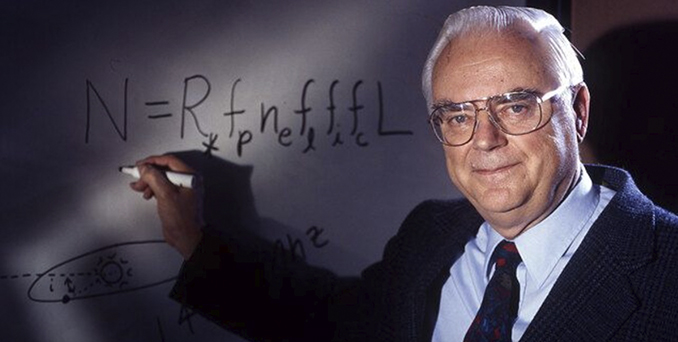Frank Drake, the radio astronomer who pioneered the search for extraterrestrial intelligence (SETI), died yesterday (2 September) at the age of 92.

Born on 28 May 1930 in Chicago, Drake was working at the Green Bank Radio Telescope during the early days of radio astronomy, in the late 1950s, when he was inspired by Giuseppe Cocconi and Philip Morrison’s famous 1959 paper in Nature about using radio transmissions at 21cm wavelength to communicate across interstellar distances. Encouraged by the director of Green Bank, Otto Struve, Drake conducted the first ever radio SETI search in April 1960. Called Project Ozma, the search utilised the 26-metre dish at Green Bank to scan two nearby stars, epsilon Eridani and tau Ceti, for extraterrestrial radio transmissions. Drake thought he had hit pay-dirt on day one, with the detection of an anomalous, pulsed signal coming from the direction of epsilon Eridani. However, the signal turned out to be from a high-altitude aircraft instead.
If extraterrestrial life existed, then it seemed reasonable to expect that it would live on planets, orbiting stars, so knowing the rate at which stars form seemed a good starting point. Then, how many of those stars form planets? How many of those planets are temperate like Earth, and how many ultimately develop simple life? Then, now how many of those worlds does that simple life evolve into complex, intelligent life? What fraction of those intelligent civilisations develop the technology for interstellar communication? And finally, how long do alien civilisations exist for, because the Universe is very old, and if technological civilisations don’t last long, the chances of our existence coinciding with theirs might be slim.
Drake wrote this all down, and realised he’s come up with an equation to estimate how many technological, communicative, extraterrestrial civilisations there may be out there. Though most of the factors in what has become known as the Drake Equation are completely unknown, meaning we can only guess at their values, that’s exactly the point. Unlike other scientific equations, it was never intended to provide an accurate answer, but rather to expose our ignorance and how much we still need to learn. Even to this day, we only know accurate values for the first two factors.
In his later years he continued to be prominent in the SETI community, acting as a public figurehead. Often called the ‘father of SETI’, his name will live on in his contributions to how we think about life beyond Earth, and how we search for evidence that we are not alone. Although we are continue to be met with silence, Drake never lost his optimism, as he showed in his words in Is Anyone Out There?
“The silence we have heard so far is not in any way significant,” he and Sobel wrote. “We still have not looked long enough or hard enough. We’ve not explored a large enough chunk of the cosmic haystack … The goal is not beyond us. It is within our grasp.”
See Astronomy Now for the complete article.
Frank Drake will be remembered for pioneering a scientific approach to search for extraterrestrial intelligence. A subsequent posting will address his famous equation and consider its predictions.